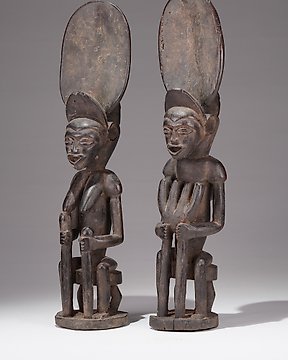
Kulango - Ivoorkust (Zonder Minimumprijs)
Nr. 84086031

Nr. 84086031

A Guerre mask, Ivory Coast, close to Liberia, village danane, of beautiful craftsmanship made out of woven rattan plants (possibly), composing a round face of expressive fascial features, tubular mouth in a kissing shape, rounded nose in the middle of the face, bulging slit hollow eyes, a small forehead, on top of which is a pack of yarn, more decorations around the jaw line of fabric and beads, then a double row of small bells, the eyes area is painted in white pigment, there are no attachment holes at the rims of the mask as usual masks have. Certificate of provenance.
“The border between Côte d'Ivoire and Liberia cuts across several ethnic groups, including the Dan, Wee, Kran, and Grebo. In Dan society, dangerous immaterial forest spirits are translated into the forms of human face masks. Whether or not they are worn, such sculptures are spiritually charged. Male performers, gle-zo, experience a dream sent by the mask spirit that allows them to dance it. In performance, the masks are integrated into the hierarchical system that governs political and religious life.
Dan masks have been documented as the embodiment of at least a dozen artistic personalities. Among these are Deangle, who ventures into the village from the initiation camps to ask women for food; Tankagle and Bagle, who entertain through a range of aesthetically pleasing dances, skits, and mimes; Gunyege, whose mask is worn by a community's champion foot racers in competitions; and Bugle, who historically leads men into battle. This example's protruding eyes and row of carved horns on the forehead indicate that this is probably a kagle mask. Kagle masks are "troublemakers", meant to disturb village festivities with their erratic movements and agressive behavior. Intended to symbolize the brutal force of the bush and of savage, nonhuman creatures, the "troublemaker" is in fact a test of the solidity of social institutions. Its disruptive performance serves a social function by teaching the value of order and discipline through its negative example.
Once they are divorced from their performance contexts, mask forms are difficult to identify. Performances of Bete and Wee masks may span the careers of many generations of wearers, contributing to the increasingly sacred status of these objects. A masquerade's vitality may also be transferred from one mask form to another. Over time, any respected Dan mask may eventually be elevated to the category gunagle, the mask that represents a village quarter, or gle wa, a judicial mask”
Lit: MET.
Zo koop je op Catawiki
1. Ontdek iets bijzonders
2. Plaats het hoogste bod
3. Veilig betalen